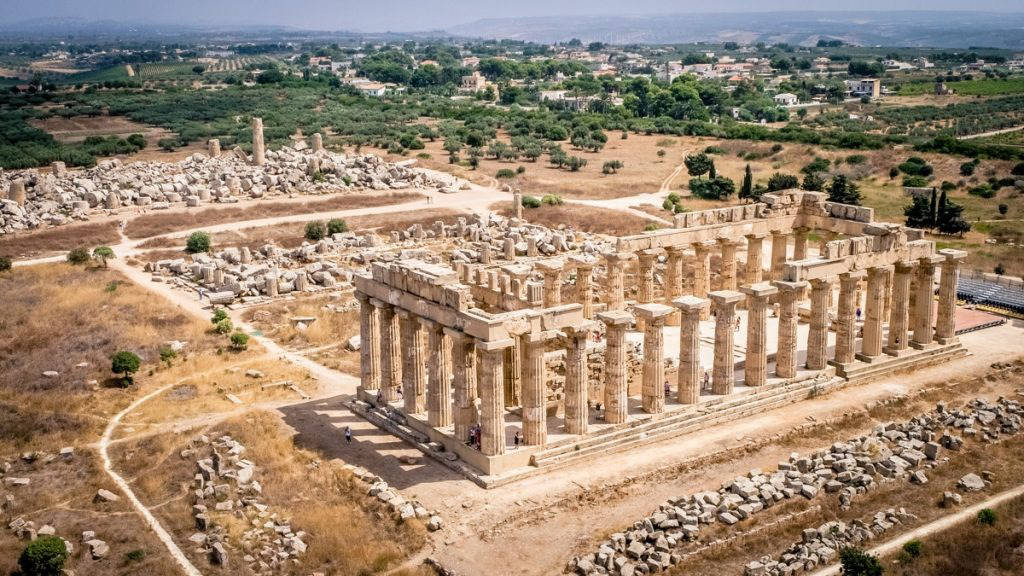Là một trong những địa điểm cổ đại lớn nhất và quan trọng nhất của Sicily, Selinunte có tám ngôi đền Hy Lạp có niên đại từ thế kỷ thứ năm trước Công nguyên, cùng với Đền Demeter gần đó. Đặc biệt và nổi tiếng nhất là những ngôi đền được gọi là Nhóm phía Đông, được đặt tên bằng chữ cái: Đền G với kích thước ấn tượng, hiện đang trong tình trạng đổ nát, là một trong những ngôi đền lớn nhất của Hy Lạp và Đền E với sự hùng vĩ về kiến trúc, được coi là đỉnh cao của thời kỳ Cổ điển.
Các ngôi đền phía đông là tuyệt đẹp nhất trong tất cả các tàn tích của Selinunte, điển hình như Đền E. Được xây dựng vào thế kỷ thứ 5 trước Công nguyên và được tái thiết vào năm 1958 trên nền móng của một toà nhà cổ, Đền E nổi bật do sự hoàn chỉnh của nó; khi bạn đi bộ từ phòng vé, đó là địa điểm đầu tiên bạn sẽ đến. Đền E còn được gọi là Đền Hera vì một dòng chữ được tìm thấy trên một tấm bia vàng mã chỉ ra rằng nó được dành riêng cho Hera; tuy nhiên, một số học giả cho rằng nó phải được dành riêng cho Aphrodite trên kiểu kiến trúc. Đây là ngôi đền được bảo tồn tốt nhất trong số các ngôi đền của Selinus, là kết quả của quá trình tái thiết được thực hiện vào năm 1959, bởi nhà khảo cổ học người Ý Jole Bovio Marconi.
Đền G, ngôi đền ở cực bắc, được xây dựng vào thế kỷ thứ 6 trước Công nguyên và mặc dù chưa bao giờ hoàn thành nhưng là một trong những ngôi đền lớn nhất thế giới Hy Lạp. Ngày nay, nó là một tàn tích hoang sơ và đầy ấn tượng - cũng như một ngôi đền khác nằm ngay phía nam, Đền F. Mặc dù một số học giả đưa ra giả thuyết rằng ngôi đền được tìm thấy trong công viên khảo cổ Selinunte này là dành riêng cho thần Zeus, ngôi đền này vẫn được gọi là "Đền G" vì không có dấu vết nào được tìm thấy có thể được sử dụng để xác định chính xác.
Đền G nằm bên ngoài ranh giới của khu định cư Selinunte, nơi có nhiều không gian hơn để xây dựng và cho lễ rước dài gắn với các nghi lễ tôn giáo. Đặc biệt, đền G là đền thờ Doric lớn thứ 4 trên thế giới Hy Lạp và lớn thứ 2 ở Sicily. Kích thước là một sự biểu dương sức mạnh và một sự phô trương lực lượng trong thế giới cổ đại được thể hiện rất rõ trong ngôi đền này.
Mặc dù hiện nay di tích này chủ yếu là một đống đổ nát, nhưng các nghiên cứu về ngôi đền này cung cấp những thông tin quý giá về các phương pháp mà các kỹ sư cổ đại đã sử dụng trong việc xây dựng của họ. Bằng cách đo lường việc sử dụng các góc có trong thiết kế ngôi đền như một thiết bị xác định niên đại, các học giả có thể xác định rằng một cuộc tấn công tàn khốc của người Carthage vào Selinunte rất có thể đã làm ngừng quá trình xây dựng. Ngoài ra, các vết lõm hình vuông có thể được nhìn thấy trên một số trống, được thiết kế như giá đỡ của các trụ chì, được chèn vào để giữ các cột lại với nhau. Các vết lõm hình chữ U cũng có thể được nhìn thấy trong một số khối đá, được sử dụng để nâng những tảng đá khổng lồ từ mỏ đá đến khu vực xây dựng.
Du khách đến tham quan sẽ được trải nghiệm những hình ảnh hoang sơ của những tàn tích còn sót lại trong những ngôi đền hùng vĩ thời kì cổ đại.



 Sicily - Ý
Sicily - Ý